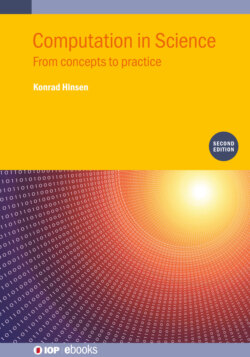Читать книгу Computation in Science (Second Edition) - Konrad Hinsen - Страница 9
На сайте Литреса книга снята с продажи.
1.1 Defining computation 1.1.1 Numerical computation
ОглавлениеThe most familiar computations are the numerical calculations that we all do in everyday life: adding up prices, multiplying the length and width of a room to compute its surface, dividing a quantity into equal parts, etc. Most people today have even more occasions for doing numerical calculations in their professional lives. Basic arithmetic on anything that can be quantified is so fundamental that it takes up a significant part of training in the first years of school. Mechanical aids for numerical operations, such as the abacus, have been used for at least 2000 years and perhaps even for much longer.
We do not think much about how we do simple arithmetic operations on small numbers, and in fact we often just recall the result that we have internalized due to frequent use. But as soon as we work on larger numbers, mental calculation becomes a mechanical activity based on rules we have learned. An example for such a rule is: to multiply a number by 9, multiply it by ten and then subtract the original number.
When operations become too complex to be handled in the head, we turn to pen and paper for a more reliable record of the intermediate results in our calculations. A large number of calculation techniques with pen and paper have been developed in the course of the centuries, ranging from addition via long division to the calculation of cube roots.
As a simple example, consider adding the numbers 173 and 51. One way to do it systematically starts by writing one below the other, adding zeros to the left of the smaller number to make the number of digits equal:
173051
We then process the digits from right to left, starting by adding 3 and 1. We ‘know’ that the result is 4, because we have done this so often. But for the slightly more complex operation of multiplication, most readers probably remember how they memorized multiplication tables in school—tables that were actually printed in books. To be precise in our description of addition, we will use an equally explicit addition table for one-digit integers:
012345678900123456789112345678902234567890133456789012445678901235567890123466789012345778901234568890123456799012345678
We actually need two such tables, the second one being for the ‘carry’ digit, which is 1 when the sum of the two digits is 10 or more, and which is 0 otherwise. We note the one-digit sum and the carry digit, and move on to the left to handle the next digit:
17305104→173051124→173051224
This method, and all the other arithmetic operations we use, rely on the positional notation for numbers that is used all around the world today. Any natural number can be written as a sequence of the digits 0 to 9. Another symbol, the minus sign, takes care of negative integers, an one further symbol, either the decimal point or the division slash, makes it possible to express fractions. The rules for arithmetic can then be formulated as rules for manipulating sequences of symbols, as shown above for addition, which can be applied mechanically.
